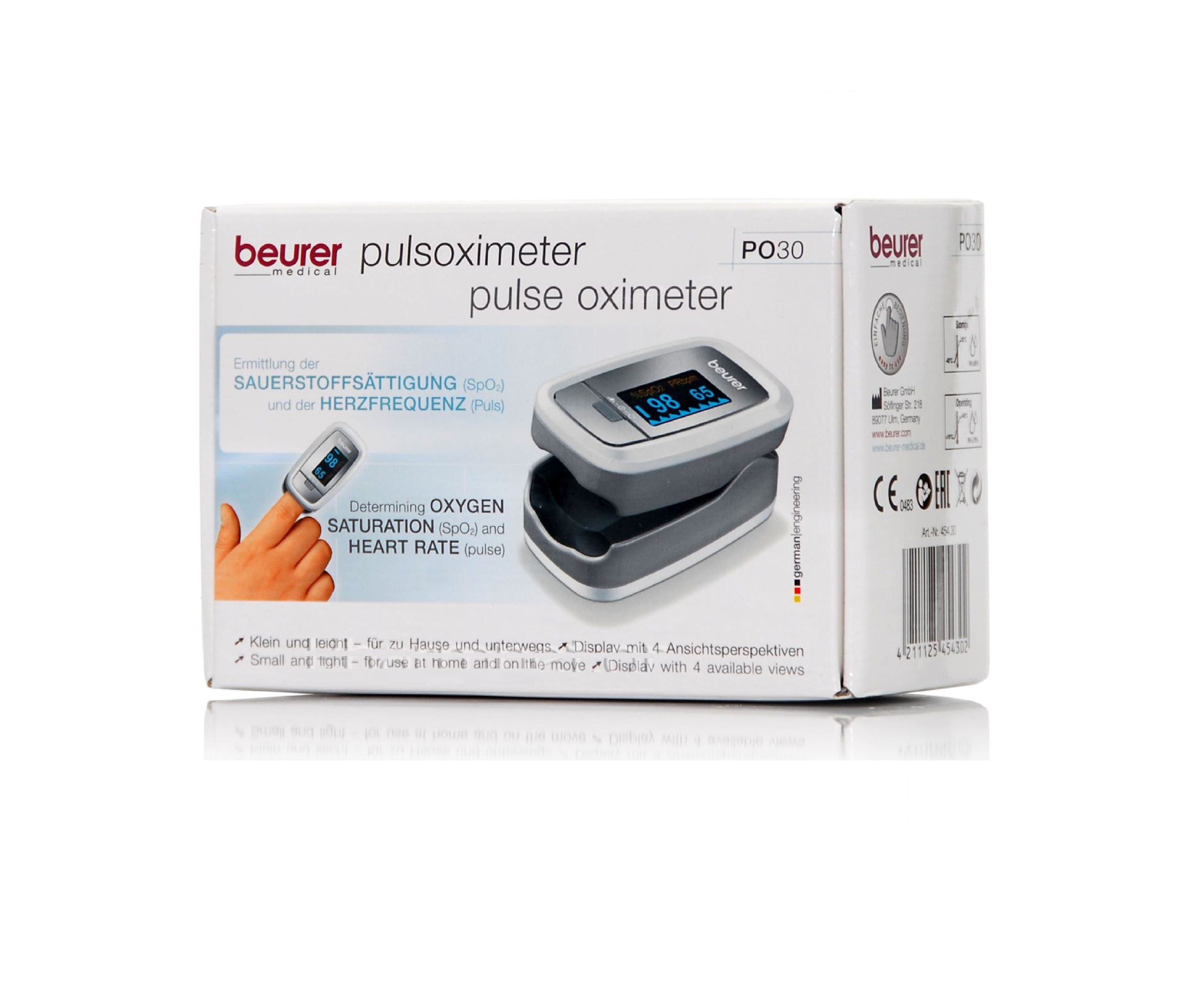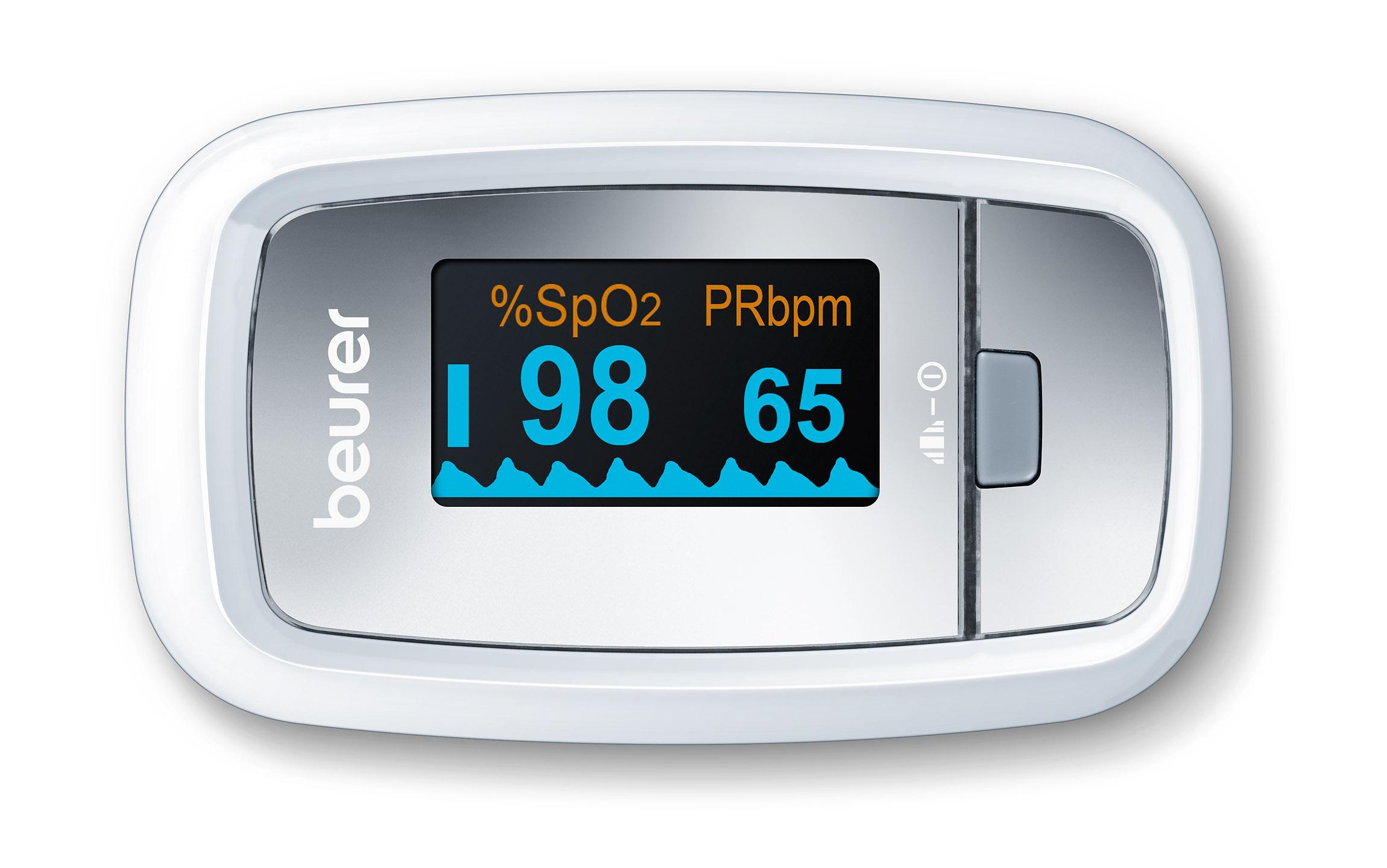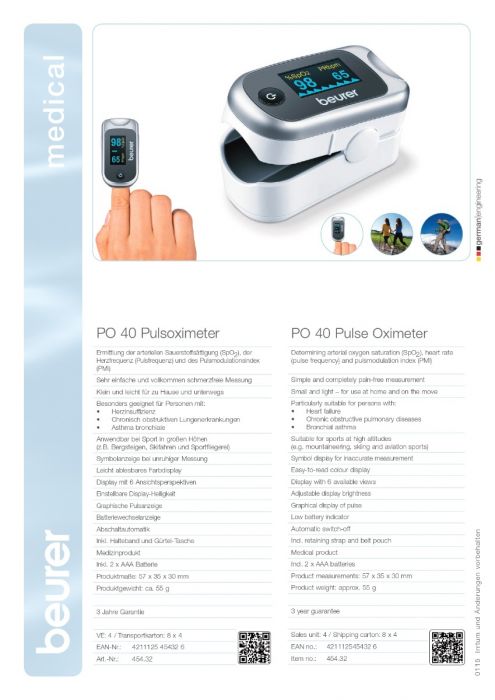The Beurer PO 60 Bluetooth Pulse Oximeter is the upgraded and latest model manufactured by the Beurer company. This model has a feature of transferring your measured values to the Beurer Health Manager application via Bluetooth. This device is particularly suitable for persons with heart failure, chronic obstructive pulmonary diseases, and also bronchial asthma.
The Beurer PO 60 Bluetooth Pulse Oximeter is a precise way to check a person’s oxygen saturation level and pulse rate.
The Beurer PO 30 pulse oximeter is an affordable, reliable and accurate way to identify your pulse rate and blood oxygen saturation level. The device is specifically designed for sports enthusiasts, aviators, bikers, mountain climbers and anyone else who wants to measure and monitor their SpO2 at their own convenience.
Beurer PO 30 Pulse Oximeter. The Beurer PO 30 is a small and light pulse oximeter for the fast and easy determination of arterial oxygen saturation in adults. To guarantee a good readability from every side, the display automatically adjusts to the posture of the finger. With this small pulse oximeter, you can easily determine your arterial oxygen saturation, heart rate and Perfusion Index.The device is small and light for use at home and on the move Measurement of SpO2 as a potential vital sign in acute illnesses, heart rate (pulse) and perfusion index (PI) Symbol display for inaccurate measurement. EASY TO USE – The Beurer Pulse Oximeter, PO60 is easy and practical to use, as the device provides a large colored display with adjustable brightness and orientation, 4 graphic display formats, auto switch-off, and low battery indicator.
Beurer PO60 Bluetooth Fingertip Pulse OximeterMain Features
The Beurer PO 60 Bluetooth Pulse Oximeter allows wireless transfer of measurements along with being small and light in size and weight. The device is for use at home and on the move as well. A strap and belt pouch is included in the package. The following are its main features:
- The device has a colour display with 4 available views.
- The device shows graphic pulse display.
- It has a low battery indicator.
- The device uses 2 AAA batteries which allows less consumption of power.
- It comes with a warranty of 5 years.
Technical Features
The device is sensitive and accurate as it measures the level of oxygen in the blood and reads the pulse rate. Following are its technical specifications:
- The device measures arterial oxygen saturation (SpO2) and heart rate (pulse) accurately.
- It has a built in 4.0 Bluetooth for transfer of measurements to your smart device.
- It has an adjustable display brightness.
- It comes with a built in memory space for 100 measurements.
- The device has an automatic switch-off feature.
Beurer Health Manager Application
The Beurer Health Manager Application is modern and networked. It allows you to keep a track of your measurements whenever you want to. It also stores your blood pressure and blood glucose activity along with the heart rate and oxygen saturation.

Beurer Health Manager software and application is available for free download and is compatible with iOS and Android via Bluetooth 4.0.
How to use Beurer PO 60 Bluetooth Pulse Oximeter?
Pulse oximetry is a fast, noninvasive, and painless test. In some cases, doctors recommend having a pulse oximeter at home.
Using a pulse oximeter at home, taking readings will let you know if the oxygen concentration is above or below certain levels. The pulse oximetry process is as follows:
- A clip-like device or probe is placed on your finger. A small pressure is felt by the individual without any pain or pinching.
- The probe should be put on the patient correctly to ensure the oximeter works correctly
- In some cases, a small probe is placed on your finger with a sticky adhesive. A person may be asked to remove your fingernail polish as it can cause complications in the accuracy of the reading.
- You’ll keep the probe on for as long as needed to monitor your pulse and oxygen saturation.
- As soon as the test is completed, the clip or probe will be removed.
- Once the test is over, the readings determine if other testing or treatment is necessary.
The Conclusion
Beurer PO 60 Bluetooth Pulse Oximeter keeps a close eye on your blood oxygen levels. Using this pulse oximeter is very easy. Furthermore, you get a user manual which makes it even easier to use. It offers a 5-year warranty. So, Beurer PO 60 Bluetooth Pulse Oximeter keeps a track of your health. Therefore, it is highly recommended to use this device for home use.
© Juan R. Velasco/Shutterstock Pulse oximeters clip on to your finger, toe, or earlobe to measure blood oxygen levels. Juan R. Velasco/Shutterstock- A pulse oximeter is a small device that can measure the oxygen saturation in your blood.
- Pulse oximetry is useful for people with chronic lung or heart conditions, who need to monitor how well oxygen is being sent from the heart and lungs out to the furthest parts of the body.
- To use a pulse oximeter, you'll clip the device on your toe, finger, or earlobe — here's to use it properly so you can get an accurate reading.
- This article was medically reviewed by Jason R. McKnight, MD, MS, a family medicine physician and clinical assistant professor at Texas A&M College of Medicine.
A pulse oximeter is a small device that typically clips on to your finger, toe, or earlobe to measure oxygen levels in the blood.
Pulse oximetry is a quick and easy way to determine how well oxygen is being sent from the heart and lungs out to the furthest parts of the body, which can help determine if your heart and lungs are functioning properly.
Pulse oximeters can be used to gauge warning signs for chronic lung or heart conditions, and may help determine whether you should seek medical attention for the coronavirus.
Here's what you need to know about what exactly a pulse oximeter measures, how it works, and how you can use it properly.

What does a pulse oximeter measure?
A pulse oximeter measures the oxygen saturation of your blood. Essentially, this percentage is a calculation of how much oxygen is in the blood, with 100% being 'fully saturated' and the optimal level.
And while this simple non-invasive medical tool is available over the counter in many pharmacies, it's not necessary for most people.
'Unless you have a chronic heart or lung condition that affects your oxygen saturation on a regular basis, most individuals don't need one in their home,' says Albert Rizzo, MD, Chief Medical Officer for the American Lung Association.
Those with lung or heart conditions — such as chronic obstructive pulmonary disease (COPD) or heart failure — may be prescribed home oxygen therapy by their doctor, says Rizzo, and a pulse oximeter can help them to monitor whether the use of oxygen at home is improving their condition or not.
Pulse oximeters have also been used to indicate severe cases of COVID-19. That's because the coronavirus can cause a decrease in blood oxygen levels — though if this occurs, it's likely that you'll recognize other symptoms before needing to use a pulse oximeter.
In fact, Rizzo says that oxygen saturation by itself is often not the best indicator of medical conditions, and other symptoms are just as important to tell your doctor.

Other warning signs of low blood oxygen levels may include:
- Increased heart rate
- increased breathing rate
- Feeling shortness of breath or gasping for air
- Inability to do an activity that you did before without getting out of breath
For everyday health, you shouldn't rely on pulse oximeter readings alone, says William Berry, Research Scientist at Harvard T.H. Chan School of Public Health. The oximeter numbers are only estimates of your blood oxygen levels — and they should be taken in context.
How does a pulse oximeter work?
To get the most accurate reading on a pulse oximeter, there are a few simple steps, according to the World Health Organization:
- Position the probe correctly. Depending on the device, this will usually be on the finger, toe, or earlobe. Make sure it is well-fitted, and not being forced on: for example, try the second toe rather than the big toe. If the probe is too loose or too tight, it may allow extra light in, which will impact the reading.
- Make sure you're sitting still. Shaking or shivering will affect the reading, and may make it seem much lower than it actually is.
- Remove any nail polish. If you're wearing colored nail polish, this might affect the reading. Finger tattoos or henna dye can also affect the reading: in this case, choose a different finger, toe, or earlobe. Cold fingers or toes can also cause false readings.
Beurer Digital Fingertip Pulse Oximeter
There are many types of pulse oximeters, which come with varying features and are sold at a range of prices, so you'll want to find the best pulse oximeter for your purposes.
A 2016 comparison between the accuracy of the pocket or standard pulse oximeter found that the standard oximeter had a precision error of 1.8%, while the pocket version showed 2.21% error. One 2018 study of pulse oximeters used in heart patients suggested that earlobe probes had greater accuracy.
Beurer Pulse Oximeter Review
If you think your pulse oximeter might not be accurate, Rizzo suggests checking the pulse reading or heart rate on the pulse oximeter against your own reading of your pulse.
How to read a pulse oximeter
According to WHO, a reading of 95% to 100% on the pulse oximeter is considered healthy and isn't a cause for concern.
If you have no underlying medical conditions, your levels should generally be at 95 or higher. But for people with chronic conditions, it's important to talk with your doctor about what the appropriate reading should be for you, and when you should seek medical attention.
For reference, lower levels of blood oxygen saturation may indicate:
- Blocked airways
- Difficulty breathing
- Lung infection
- Poor blood circulation
- Drug interference from anesthesia, muscle relaxants, or anaphylaxis
In addition, if your pulse oximeter reading drops during exercise, Rizzo says it can be a sign of an underlying lung or heart condition and you should speak with your doctor.
Related articles from our Health Reference library:
Read the original article on Insider